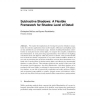Free Online Productivity Tools
i2Speak
i2Symbol
i2OCR
iTex2Img
iWeb2Print
iWeb2Shot
i2Type
iPdf2Split
iPdf2Merge
i2Bopomofo
i2Arabic
i2Style
i2Image
i2PDF
iLatex2Rtf
Sci2ools
JGTOOLS
2008
2008
Subtractive Shadows: A Flexible Framework for Shadow Level of Detail
Abstract. We explore the implications of reversing the process of shadow computation for real-time applications that model complex reflectance and lighting (such as that specified by an environment map). Instead of adding illumination contributions at each pixel across various lights, we compute the complete, unshadowed local illumination at each pixel using approximations, then subtract the lighting contribution from each light for which the pixel is in shadow. This provides flexible level of detail for shadow computation in ways that standard additive shadows do not, such as permitting the use of fast methods for accurate direct illumination combined with a small number of shadow-casting lights, and allowing for downsampled shadows to reduce fill cost. This technique preserves that portion of the scene with the greatest visual importance--the direct illumination--and allows shadows to be presented with lower fidelity in exchange for improvements in speed. With subtractive shadows, we...
| Added | 13 Dec 2010 |
| Updated | 13 Dec 2010 |
| Type | Journal |
| Year | 2008 |
| Where | JGTOOLS |
| Authors | Christopher DeCoro, Szymon Rusinkiewicz |
Comments (0)

